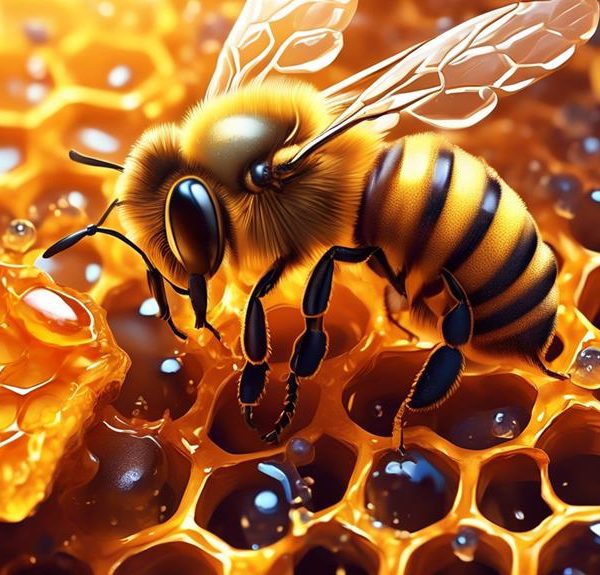Discover safe and effective methods for evicting bees from your brick wall without harming the environment or yourself.
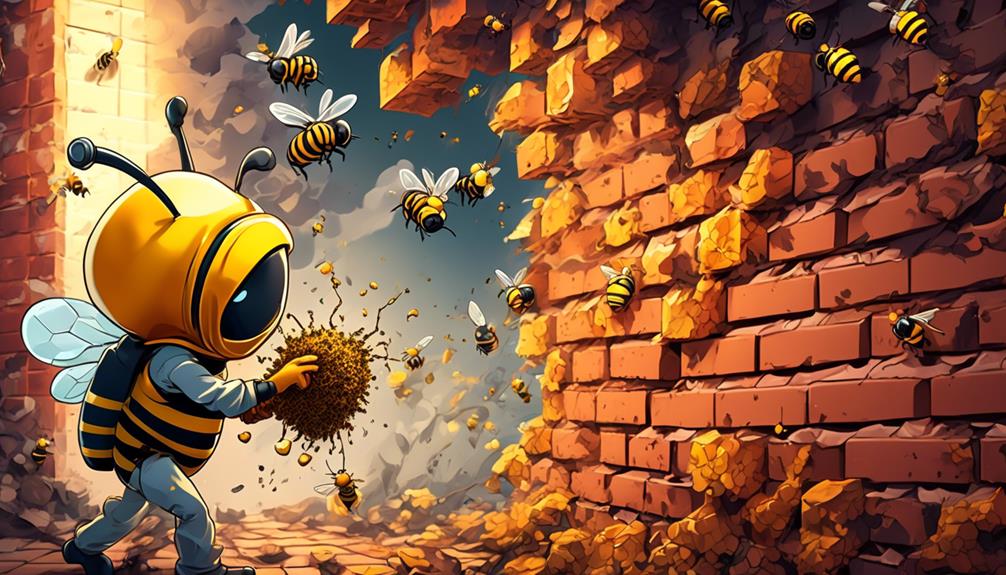
How to Get Rid of Bees in Brick Wall?
Just as a castle wall hides much more than it reveals, you too may find a bustling colony of bees living behind your seemingly unassuming brick wall. Now, it's important for you to remember that bees aren't your sworn enemies. They're essential pollinators that contribute significantly to our ecosystem.
However, when they set up shop in your house, it's a different ball game. You'd want to ensure their removal without causing harm to them or yourself. But where do you start? How do you safely evict these tiny tenants from your brick wall?
Let's arm you with the knowledge you need to tackle this buzzing problem.
Key Takeaways
- Accurately identify the bee species before attempting removal to choose the right method.
- Bees are active during the day and rest at night, with some species being more active at dawn or dusk.
- Bees prefer nesting in protected, enclosed spaces like brick walls or tree hollows.
- Bees should be relocated instead of exterminated to preserve their role in pollination.
Identifying the Bee Species
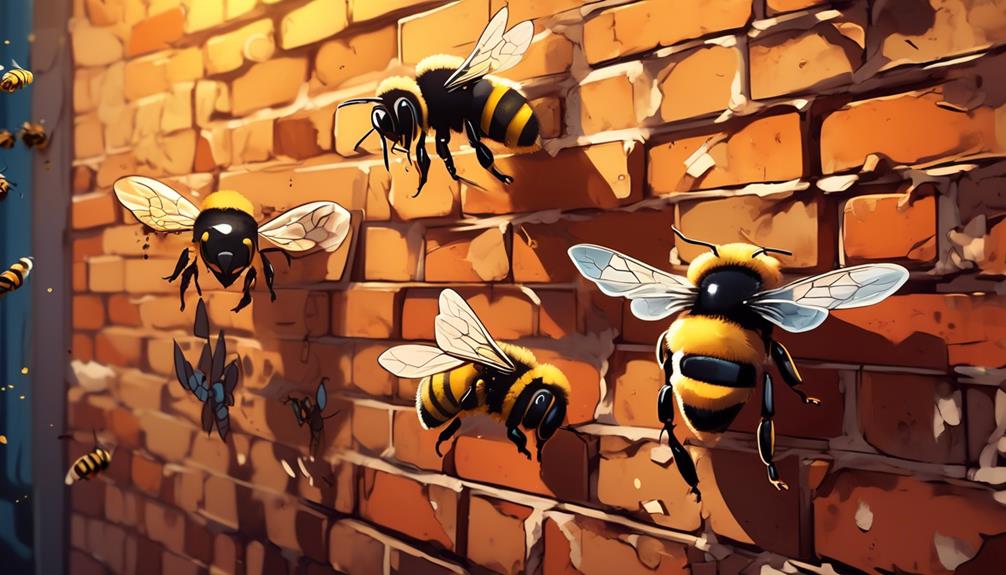
Before you can successfully eliminate the bees in your brick wall, it's crucial to accurately identify the bee species you're dealing with. This isn't just a matter of curiosity; different bee species exhibit different behaviors, nesting habits, and levels of aggressiveness. Understanding these differences will help you choose the most effective and safe removal method.
First, let's start with honey bees. They're usually golden-brown and black, and they have a fuzzy appearance. Honey bees are beneficial for the environment due to their pollination activities, so instead of killing them, it's recommended to relocate them.
Next, you have carpenter bees. They're large, black, and shiny, and unlike honey bees, they don't live in colonies. Carpenter bees are solitary bees that bore holes into wood to lay their eggs, so they're less likely to infest your brick wall.
Finally, you might encounter yellow jackets. These wasps are black with yellow stripes and are more aggressive than bees. They often build nests in wall voids, including brick walls. If you spot these insects, you should call a professional exterminator, as their stings can be dangerous.
Understanding these differences will ensure you're dealing with your bee problem in the most effective way.
Understanding Bee Habits

To effectively handle a bee infestation in your brick wall, it's essential to understand the habits and behaviors of the bee species you're dealing with. Knowing their common nesting locations, activity patterns, and aggression levels can aid in your bee removal efforts.
Most bees are active during the day and rest at night, but some species may be more active at dawn or dusk. They typically prefer to nest in protected, enclosed spaces like your brick wall, tree hollows, or underground. Yet, the specific nesting habits can vary greatly depending on the species.
When it comes to aggression, most bees aren't naturally aggressive unless provoked. However, Africanized honey bees are known to be highly aggressive and can pose serious threats. Other species may only become defensive when their nests are disturbed.
Lastly, remember that bees play a crucial role in pollination, so it's always better to relocate them rather than exterminate. Be sure to consult a professional if you're unsure about handling the situation. Understanding these habits won't only help you manage the situation but also do so in a way that respects these beneficial insects.
Preparing for Bee Removal
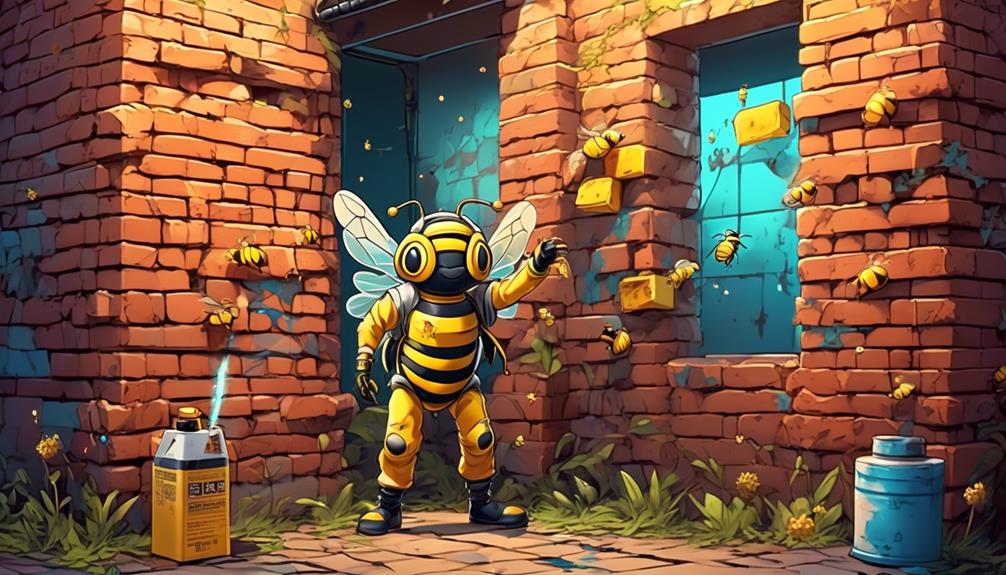
Gearing up for bee removal requires careful planning and the right protective gear to ensure your safety during the process. Don't underestimate the importance of adequate preparation. It's not just about donning a bee suit and charging in. You'll need to strategize and equip yourself properly to avoid unnecessary stings or agitating the hive.
Firstly, you should invest in a high-quality bee suit that covers your entire body, including your face and hands. Ensure it's made of thick material that bees can't penetrate. Also, have a pair of sturdy gloves that extend past your wrists and secure tightly to prevent bees from crawling inside.
Next, plan your approach. Identify the exact location of the hive and the most accessible point. This will help you determine the best and safest route to reach the nest.
Lastly, consider the right time to intervene. Bees are less active during cooler parts of the day, so early morning or late evening might be the best times to proceed.
Safe and Effective Removal Methods
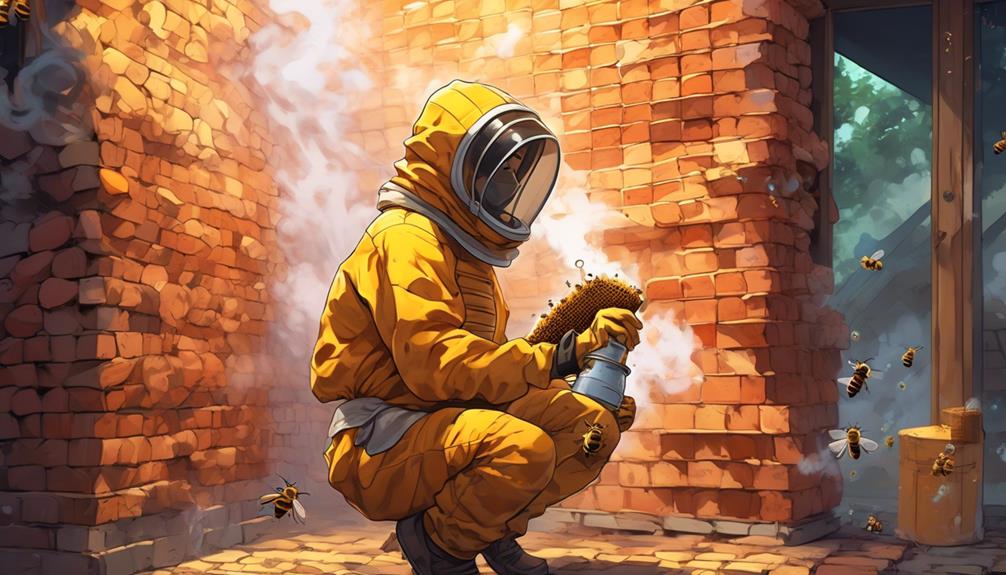
Having adequately prepared yourself and understood the hive's location and the insects' activity patterns, you're now set to explore various safe and effective methods for bee removal. There are several professional methods you can consider, like smoke, insecticides, and professional beekeeper assistance.
Method | Description |
|---|---|
Smoke | This involves using a smoker to calm the bees and encourage them to leave the hive. It's a non-lethal method that's especially effective in daytime when bees are active. |
Insecticides | Some professionals recommend using insecticides designed for bees. However, this method should be your last resort as it can harm the insects and the environment. |
Beekeeper Assistance | Professional beekeepers can safely remove and relocate the bees. It's the most eco-friendly method, ensuring minimal harm to these beneficial insects. |
Post-Removal Care and Prevention

Once the bees are safely removed, it's crucial you take steps to prevent any future infestations and care for the area previously occupied by the hive. Start by thoroughly cleaning the spot. Bee hives leave behind a strong scent that can attract other bees. Use a solution of one part vinegar and one part water to scrub the area and neutralize the smell.
Seal any cracks or openings in the brick wall with a high-quality caulk. Bees are attracted to small, enclosed spaces, and sealing off potential entry points is an effective deterrent. Make sure to check the entire exterior of your home, not just the area where the hive was located.
Regular maintenance is key to preventing a recurrence. Schedule periodic inspections of your property, especially during the spring and summer when bees are most active. If you notice any signs of bee activity, such as bees hovering around a specific spot, don't hesitate to call a professional.
Lastly, consider planting bee-repellent plants around your home. Species such as citronella, peppermint, and eucalyptus are known to deter bees. However, remember that bees play a vital role in pollination and should be relocated rather than exterminated whenever possible.
Frequently Asked Questions
What Are the Legal Protections for Bees in My Area and How Do They Impact My Removal Options?
Your local legal protections for bees can greatly impact your removal options. Some areas have strict regulations, forbidding harm to bees, which are crucial pollinators. You're often required to call professionals for safe relocation.
It's best to check with local authorities or a beekeeper association in your area to understand the guidelines. Non-compliance may result in severe penalties.
Can Bees Cause Structural Damage to a Brick Wall Over Time?
Yes, bees can cause damage to your brick wall over time. They don't directly harm the bricks, but their nesting activity can weaken the mortar. If water seeps in and freezes, it can cause further damage.
It's also possible for a large hive to create pressure that damages the structure. Therefore, it's important to address a bee infestation promptly to prevent potential harm to your home.
Are There Any Health Risks Associated With Living in Close Proximity to a Bee Colony?
Living near a bee colony can pose health risks, especially if you're allergic to bee stings. Reactions can range from mild discomfort to severe anaphylaxis, which can be life-threatening.
Even without allergies, multiple stings can still cause serious harm. Bees can also be a nuisance, disrupting your outdoor activities.
It's important to contact a professional pest control service if you have a bee colony near your home.
How Long Does It Typically Take for Bees to Completely Vacate a Wall After a Professional Removal?
After a professional bee removal, it typically takes about a week for the bees to completely vacate a wall. However, this can vary depending on factors like the size of the colony and the methods used.
You'll want to seal any entrances after they've left to prevent a new swarm from moving in.
It's also advisable to clean the area to deter other pests attracted to the leftover honey and wax.
What Are the Potential Costs Associated With Professional Bee Removal Services?
The costs of professional bee removal services can vary greatly based on several factors. You're looking at a range from $100 to $1000. It all depends on the complexity of the job. If the bees are located in a hard-to-reach area or if there's a large hive, you'll pay more.
Also, rates might differ from one company to another. It's advisable to get several quotes to ensure you're getting a fair deal.
Conclusion
In conclusion, you've now learned how to:
- Identify the bee species
- Understand their habits
- Prepare for removal
- Apply safe methods
Remember, it's crucial to prioritize safety and enlist professional help if needed.
After successful bee removal from your brick wall, don't neglect post-removal care and prevention.
Keep these practices ongoing to ensure a bee-free environment. Bees are beneficial for the ecosystem, but they also need appropriate spaces to thrive, away from human habitats.

